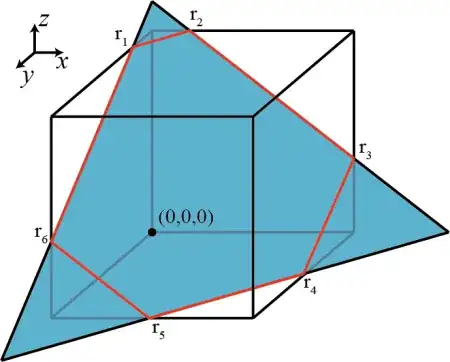Method I - area from volume
Assume $m_1, m_2, m_3 > 0$ and let $\vec{m}$ be the vector $(m_1,m_2,m_3)$. WOLOG, we will assume $m_i$ are normalized such that $|\vec{m}| = 1$.
Let $\theta(t)$ and $\phi(t)$ be the functions defined by
$$\theta(t) = \begin{cases}t,& t \ge 0\\0,&\text{ otherwise }\end{cases}
\quad\text{ and }\quad
\phi(t) = \frac{1}{6m_1m_2m_3}\theta(t)^3.
$$
For any $\vec{x} = (x_1,x_2,x_3) \in \mathbb{R}^3$, consider the simplex "at" $\vec{x}$.
$$\Delta(\beta, \vec{x}) = \bigg\{\; \vec{y} = (y_1,y_2,y_3) \in \mathbb{R}^3 : y_1 \ge x_1, y_2 \ge x_2, y_3 \ge x_3\;\text{ and }\;\vec{m}\cdot\vec{y} \le \beta \;\bigg\}$$
It is easy to see
$$\text{Vol}(\Delta(\beta, \vec{x})) = \text{Vol}(\Delta(\beta - \vec{x}\cdot\vec{m}, \vec{0}))
= \phi(\beta - \vec{x}\cdot\vec{m})
$$
Let use call the area we want to compute as $A(\beta)$. To compute it, we will
first compute the volume of that portion of unit cube
beneath the plane $\vec{x}\cdot\vec{m} \le \beta$ as a function of $\beta$. i.e.
$$V(\beta)\;\stackrel{def}{=}\;\text{Vol}( [0,1]^3 \cap \Delta(\beta,\vec{0}) )$$
Let $t$ be a variable start at $0$ and increases to its final value $\beta$.
For small $t$, $\Delta(t,\vec{0})$ lies completely inside the unit cube. As
a result, $V(t)$ is equal to $\phi(t)$.
As we increases $t$, the plane $\vec{m}\cdot\vec{x} = t$ will hit
one of the three vertices $(1,0,0)$, $(0,1,0)$, $(0,0,1)$ of the unit cube.
Let we call this vertex $\vec{v}$. A small portion
of $\Delta(t,\vec{0})$ (which itself is a simplex having $\vec{v}$ as a vertex)
now lies outside the unit cube. We need to subtract
its volume $\text{Vol}(\Delta(t,\vec{v})) = \phi(t -\vec{m}\cdot\vec{v}) $ from $V(t)$.
As we increases $t$ further, the plane $\vec{m}\cdot\vec{x} = t$ will hit
one of the three vertices $(0,1,1)$, $(1,0,1)$, $(1,1,0)$. Let's say it is
$\vec{w} = (1,1,0)$ that get hit. The two small simplices at $(1,0,0)$ and $(0,1,0)$ we encountered in step $2$ will now overlap. This means the subtraction of their volume from $V(t)$ in step $2$ is now an overkill. We need to add back the volume of their intersection $\text{Vol}(\Delta(t,\vec{w})) = \phi(t - \vec{m}\cdot\vec{w}))$ to $V(t)$.
As we increases $t$, the plane $\vec{m}\cdot\vec{x} = t$ will hit more and more vertices. We can organize this subtraction, add back cycle using the inclusion exclusion
principle.
In the end, if we let $\vec{v}_i$, $i = 1,\ldots, 8$ be the $8$ vertices of the unit cube
and $\epsilon_i$ be the corresponding parity, i.e
$$\epsilon_i = \begin{cases}
0, &\vec{v}_i = (0,0,0), (0, 1, 1), (1,0,1), (1,1,0)\\
1, &\vec{v}_i = (1,0,0), (0, 1, 0), (0,0,1), (1,1,1)
\end{cases}$$
We can express $V(\beta)$ in a compact form
$$
V(\beta) = \sum_{i=1}^{8} (-1)^{\epsilon_i}\phi(\beta - \vec{m}\cdot\vec{v}_i)
$$
Recall $\vec{m}$ has been normalized as an unit vector. If we increase $\beta$ for an infinitesimal amount $\delta\beta$, the change in volume will be dominated by a
term proportional to $A(\beta)\delta\beta$. More precisely,
$$V(\beta + \delta\beta) - V(\beta) = A(\beta)\delta\beta + O((\delta\beta)^2)$$
This leads to a compact formula for the area we want.
$$\bbox[4pt,border:1px solid blue]{
A(\beta) = \frac{dV(\beta)}{d\beta} = \frac{1}{2m_1m_2m_3}\sum_{i=1}^{8}(-1)^{\epsilon_i}\theta(\beta - \vec{m}\cdot\vec{v}_i)^2
}
$$
Let's use the configuration depicted in the picture in question as an example.
In that case, 4 and only 4 vertices $(0,0,0), (1,0,0), (0,1,0), (0,0,1)$ lies beneath the plane $\vec{m}\cdot\vec{x} = \beta$. RHS of above formula
reduces to following quadratic polynomial in $\beta$.
$$A(\beta) = \frac{1}{2m_1m_2m_3}\left[\beta^2 - (\beta-m_1)^2 - (\beta-m_2)^2 - (\beta-m_3)^2\right]$$
Method II - as a general planar polygon
Following is another way to evaluate the area. Please note that there is no need to
transform points $r_i$ to a plane align to the coordinates system first.
Let $\vec{x}_1, \vec{x}_2,\ldots,\vec{x}_n$ be the vertices of a planar polygon $X$ in $\mathbb{R}^3$. Let $P$ be the plane in $\mathbb{R}^3$ holding the polygon $X$
and let $\vec{p}$ be a unit normal vector of $P$. We will assume when we view the plane $P$ from the side pointed by $\vec{p}$, the vertices $\vec{x}_1, \vec{x}_2, \ldots, \vec{x}_n$ are arranged in counter-clockwise manner. For simplicity of expression below, we will
use $\vec{x}_{n+1}$ as an alias for $\vec{x}_1$.
Given any $3$ points $\vec{y}_1, \vec{y}_2, \vec{y}_3 \in P$, arranged counter-closewisely with respect to $\vec{p}$, let $A(T)$ be the area of the triangle $T$ formed by them. We have
$$\begin{align}
A(T) \vec{p} &= \frac12 (\vec{y}_2 - \vec{y}_1) \times (\vec{y}_3 - \vec{y}_1)\\
\implies \quad
A(T) &= \frac12\vec{p}\cdot\left[\vec{y}_1 \times \vec{y}_2 + \vec{y}_2 \times \vec{y}_3 + \vec{y}_3 \times \vec{y}_1\right]
\end{align}
$$
One thing you should notice is the area $A(T)$ is the sum of 3 pieces, each coming from an edge of $T$.
If we break the polygon $P$ into $n$ small triangles and apply above formula to the small triangles, the contributions form the internal edges all cancelled out. At the end,
we get
$$A(P) = \frac12 \sum_{i=1}^n \vec{p} \cdot ( \vec{x}_i \times \vec{x}_{i+1})$$
This formula is very similar to what you have for polygon in $\mathbb{R}^2$. Apply these to your $r_i$, your area is equal to${}^{\color{blue}{[1]}}$
$$\frac12 \left(
\begin{align}
&\phantom{+} \vec{m}\cdot(r_1 \times r_2) + \vec{m}\cdot(r_2 \times r_3) + \vec{m}\cdot(r_3 \times r_4) \\
&+ \vec{m}\cdot(r_4 \times r_5) + \vec{m}\cdot(r_5 \times r_6) + \vec{m}\cdot(r_6 \times r_1)\end{align} \right)
$$
If you substitute your expression of $r_i$ into it and throw the mess to a CAS, it
can be simplified to something like
$$\begin{align}&\frac{m_1^2+m_2^2+m_3^2}{2m_1m_2m_3} \left(
-2b^2 + 2(m_1+m_2+m_3)b - (m_1^2+m_2^2+m_3^2)\right)\\
= &\frac{1}{2m_1m_2m_3}\left(b^2 - (b-m_1)^2 - (b-m_2)^2 - (b-m_3)^2\right)
\end{align}
$$
Reproducing what we get by method I.
Notes
- $\color{blue}{[1]}$ Please note that in the your picture, $r_1, r_2, \ldots, r_6$ are ordered clockwisely with respect to $\vec{m}$. If that is really the case, one should add
an minus side to the area. However, you have drawn your coordinate system opposite to the usual convention. If you draw your picture in the usual right-handed coordinate system, they will be ordered counter-clockwisely instead of clockwisely.
